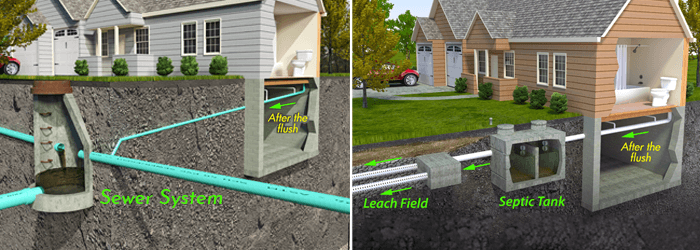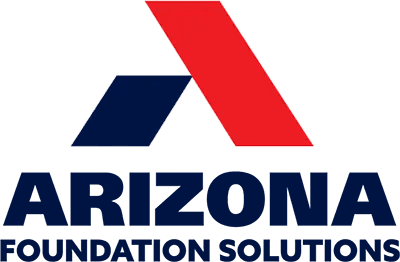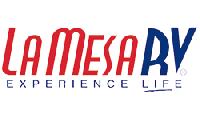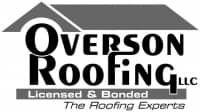There are DOs and DON’Ts whether you are connected to a sewer system, or you are on a septic system. Some of these DOs and DON’Ts differ depending upon which you are connected to. To best understand those DOs and DON’Ts, let us first look into “how” they both work to better understand the “why” these DOs and DON’Ts exist. We are going to begin with the waste line that leaves your home in both explanations and try to stay out of the scientific weeds with a broad brush explanation.
Sewer Systems
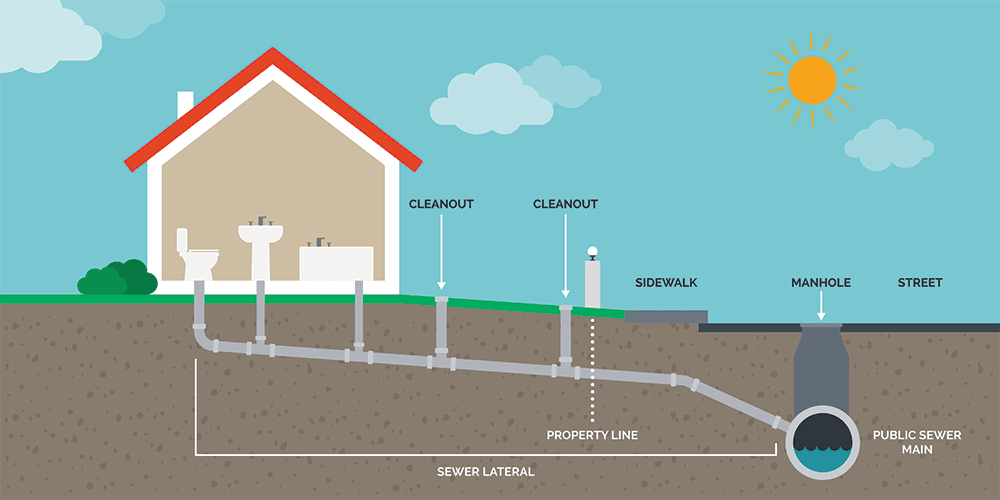
Sewer systems in Arizona are commonly associated with either a municipality or a Sanitary District, a quasi-governmental agency with some limited enforcement capabilities. If you build a home where a connection to a sewer system is available, you will likely be required by the governing body to connect to that sewer system. No choice here.
The system collects waste from your home or business and through a piping system that relies on gravity and/or forced pumping. Usually, it’s a combination of both. The goal is to deliver the waste to a central location where it will be treated, and most of the liquid (treated water) will be returned to the environment.
Treatment
How the treatment systems work dictates the DOs and DON’Ts of what goes into your personal waste system.
There are three steps to treating wastewater.
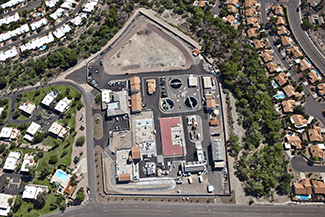
1 | The first step, after collection and delivery to the facility, is to pass the waste through a screening process to capture large items and debris that might damage the treatment plant. Some systems have multiple screens for this step. Once into the plant and maybe a grinder, air is introduced. This is the aeration process. This begins to introduce beneficial bacteria to the process of helping to break down the waste products. After aeration, the waste is put into a sedimentation holding area. This is where the solids essentially fall to the bottom and the water remains on top, separating the two.
2 | Step two further mixes the “sludge” with the water to facilitate the growth of bacteria and other microorganisms. These break down the organic matter into harmless byproducts. The wastewater may then be sent to another round of sedimentation tanks if necessary.
3 | Step three moves the water through a process to remove the harmful bacteria before reintroducing it to the environment. The removal of the bacteria can be done utilizing chemicals such as chlorine, ultraviolet light, or ozone that can be used to purify the water.
After these three steps, the water is used for irrigation, such as at golf courses. However, it is not fit for human consumption. Many treatment facilities will pump this water back into the ground where percolation will finalize the water purification and recharge our groundwater storage.
Septic Systems
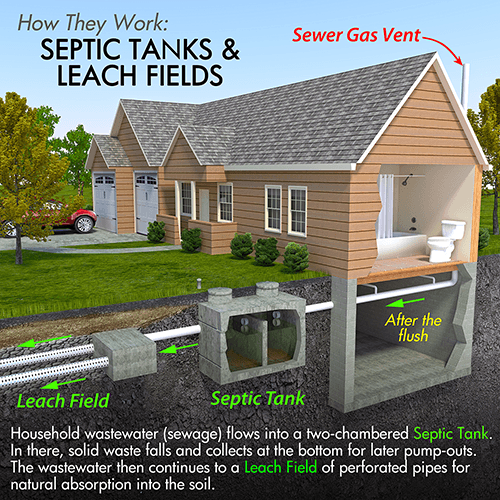
When a sewer system is not available, a septic system is used to treat waste.
We have talked about home septic systems on many occasions. There are many blogs in our Rosie on the House database. For our discussion here, a review of how your septic systems work might be in order.
Once the wastewater flows out of your home, it is delivered by gravity to a holding or septic tank buried on your property. This tank collects the wastewater and separates the solids from the liquid by settling in the tank. Your tank may or may not have two sections separated by a baffle that allows liquid to pass over the top while minimizing solid transfer but not completely eliminating them. The second baffle holding area allows the remaining solids to settle here. The remaining liquid flows out of a pipe near the top of the tank and is transported by gravity to a disbursement field, or leach field, where it percolates back into the ground. Since the disbursement pipe is usually within a couple of feet from the ground surface, water is also introduced back into the environment through evaporation.
So, those are the basics of how each system works. The similarities help define some of the DON’Ts. Because both systems rely on essential bacteria to break down solids, a big DON’T is putting anything down the drain that might harm the bacteria.
DON’T
- Hazardous materials of any kind should never be dumped into your drain, whether septic or sewer.
- No pesticides
- No oils
These will harm the processes necessary to break down the waste. Other items that appear on the DON’T list are primarily to avoid clogging up the waste lines for both sewer and septic and also do not break down well or at all in the septic tank.
More DON’Ts for both sewer and septic
- Diapers
- Baby wipes, even when the package says “flushable.”
- Facial tissues.
- Sanitary products
For those of us connected to sewer systems, there is not much you need to do to help the system other than keeping your lines open and not doing the DON’Ts. The operators of the sewer systems have the maintenance part handled.
Your septic system maintenance relies on you. Check out this link to some of our best tips to take care of your septic system. This will lay out several of the DOs for your home system.
While there are some similarities between sewer systems and septic systems, the most glaring difference is what you need to do from an operational perspective. With a septic system, you need to be far more engaged with the system’s health to ensure operational longevity.
###
PODCAST
When toilets are flushed, the wastewater goes to a city sewer system or a stand alone septic tank. We touch on how they function. Plus homeowner questions on a inch and a half drop from garage to paver driveway, algae buildup in a solar water heater, casitas, building a garage near a shade tree, why are electric panels outdoors, and more!
Podcast Archive With Expanded Content and Resources
PHOTO CREDIT
- Shutterstock

